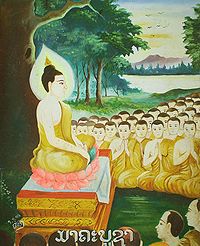
Magha Puja
Encyclopedia
Māgha Pūjā or Makha Bucha (Lao
: ມະຄະບູຊາ; (Pronunciation); Khmer: មាឃបូជា) is an important Buddhist festival celebrated in Thailand
, Cambodia
, and Laos
on the full moon day of the third lunar month
(this usually falls in February). The third lunar month is known in the Thai language as Makha (Pali: Māgha); Bucha is also a Thai word (Pali: Pūjā), meaning "to venerate" or "to honor". As such, Makha Bucha Day is for the veneration of Buddha
and his teachings on the full moon day of the third lunar month.
The spiritual aims of the day are: not to commit any kind of sins; do only good; purify one's mind.
Māgha Pūjā is a public holiday in Thailand, Laos and Cambodia - and is an occasion when Buddhists tend to go to the temple to perform merit-making activities.


The Buddha gave an important teaching to the assembled monks on that day 2,500 years ago called the 'Ovādapātimokha' which laid down the principles of the Buddhist teachings. In Thailand, this teaching has been dubbed the 'Heart of Buddhism'.
Lao language
Lao or Laotian is a tonal language of the Tai–Kadai language family. It is the official language of Laos, and also spoken in the northeast of Thailand, where it is usually referred to as the Isan language. Being the primary language of the Lao people, Lao is also an important second language for...
: ມະຄະບູຊາ; (Pronunciation); Khmer: មាឃបូជា) is an important Buddhist festival celebrated in Thailand
Thailand
Thailand , officially the Kingdom of Thailand , formerly known as Siam , is a country located at the centre of the Indochina peninsula and Southeast Asia. It is bordered to the north by Burma and Laos, to the east by Laos and Cambodia, to the south by the Gulf of Thailand and Malaysia, and to the...
, Cambodia
Cambodia
Cambodia , officially known as the Kingdom of Cambodia, is a country located in the southern portion of the Indochina Peninsula in Southeast Asia...
, and Laos
Laos
Laos Lao: ສາທາລະນະລັດ ປະຊາທິປະໄຕ ປະຊາຊົນລາວ Sathalanalat Paxathipatai Paxaxon Lao, officially the Lao People's Democratic Republic, is a landlocked country in Southeast Asia, bordered by Burma and China to the northwest, Vietnam to the east, Cambodia to the south and Thailand to the west...
on the full moon day of the third lunar month
Thai lunar calendar
The Thai lunar calendar , or Dai calendar , Tai calendar, is Thailand's version of the lunisolar Buddhist calendar used in the southeast Asian countries of Cambodia, Laos and Burma, for calculating lunar-regulated holy days...
(this usually falls in February). The third lunar month is known in the Thai language as Makha (Pali: Māgha); Bucha is also a Thai word (Pali: Pūjā), meaning "to venerate" or "to honor". As such, Makha Bucha Day is for the veneration of Buddha
Gautama Buddha
Siddhārtha Gautama was a spiritual teacher from the Indian subcontinent, on whose teachings Buddhism was founded. In most Buddhist traditions, he is regarded as the Supreme Buddha Siddhārtha Gautama (Sanskrit: सिद्धार्थ गौतम; Pali: Siddhattha Gotama) was a spiritual teacher from the Indian...
and his teachings on the full moon day of the third lunar month.
The spiritual aims of the day are: not to commit any kind of sins; do only good; purify one's mind.
Māgha Pūjā is a public holiday in Thailand, Laos and Cambodia - and is an occasion when Buddhists tend to go to the temple to perform merit-making activities.


Origin of Māgha Pūjā Day
Māgha Pūjā day marks the four auspicious occasions, which happened nine months after the Enlightenment of the Buddha at Veḷuvana Bamboo Grove, near Rājagaha in Northern India. On that occasion, as recorded in the commentary to the Mahāsamayasutta, DN-Comm 20) four marvellous events occurred:- There were 1,250 Arahata, that came to see the BuddhaBuddhaIn Buddhism, buddhahood is the state of perfect enlightenment attained by a buddha .In Buddhism, the term buddha usually refers to one who has become enlightened...
that evening without any schedule. - All of them were Arhantas, the Enlightened One, and all of them were ordained by the Buddha himself.
- The Buddha gave those Arhantas principles of the Buddhism, called "The ovadhapatimokha". Those principles are: - To cease from all evil,- To do what is good,- To cleanse one's mind;
- it was the full-moon day.
The Buddha gave an important teaching to the assembled monks on that day 2,500 years ago called the 'Ovādapātimokha' which laid down the principles of the Buddhist teachings. In Thailand, this teaching has been dubbed the 'Heart of Buddhism'.
Activities to be observed on Māgha Pūjā Day
- In the evening of Magha full-moon day, each temple in Thailand holds a candlelight procession called a wian tian (wian meaning circle; tian meaning candle). Holding flowers, incense and a lighted candle, the monks and congregation members circumambulate clockwise three times around the Uposatha Hall - once for each of the Three Jewels – the Buddha, the Dharma, and the Sangha.
- Tum Boon: Making merit by going to temples for special observances and join in the other Buddhist activities.
- Rub Sil: Keeping the Five Precepts. Practise of renunciation: Observe the Eight Precepts, practise of meditation and mental discipline, stay in the temple, wearing white robes, for a number of days.

